| کد مقاله | کد نشریه | سال انتشار | مقاله انگلیسی | نسخه تمام متن |
|---|---|---|---|---|
| 944336 | 1475522 | 2010 | 12 صفحه PDF | دانلود رایگان |

RésuméSi la psychologie et la psychiatrie de l’enfant doivent d’évidence intégrer très naturellement les apports récents des neurosciences et des perspectives cognitives et fonctionnelles dans leurs modes de compréhension de la souffrance de l’enfant dans toutes ses dimensions (affective, instrumentale, développementale et intersubjective) autant que dans leurs réponses thérapeutiques, il nous semble que cette intégration se fait d’une manière parcellaire, conflictuelle et antipsychique, alors qu’elle devrait se penser de manière complémentaire, et être un authentique appel pour une articulation pluridimensionnelle, mieux un plaidoyer pour la complexité du petit d’homme en développement ! On constate de plus que la confrontation des neurosciences et de la psychanalyse passe trop souvent à côté de son objet dans de longs dialogues de sourds en shuntant les points d’articulations potentiels entre le neurone et l’inconscient ! Ce saut mystérieux paraît incompréhensible tant qu’on n’aura pas mesurer que ces articulations se tissent à travers l’histoire développementale du sujet et à travers les expériences de son « corps-en-relation ». Le « carrefour psychomoteur » (expérience du corps vécu dans le développement) est – entre fonctions et fonctionnements – le chaînon manquant à nombre de pathologies développementales et instrumentales autant qu’à l’élaboration de l’articulation effective entre l’équipement et le potentiel neurocognitif, son déploiement dans le développement et son investissement subjectif et pulsionnel au décours de la vie psychique de la personne. La clinique (le THADA et les déficits attentionnels, les troubles instrumentaux et l’exemplarité de la dyspraxie ; ou encore le paradigme autistique) nous oblige à engager la réflexion plus loin qu’à une simple lecture contradictoire de deux modèles, mais bien à une tentative d’articulation tant théorique que thérapeutique de la pathologie de ces jeunes patients. Plutôt qu’à une appréhension des fonctions et de leurs spécificités, c’est bien aux avatars du fonctionnement des dites fonctions que la psychopathologie renvoie toujours.
If the psychology and the psychiatry of the child owe of evidence integrate very naturally the recent contributions of the neurosciences and the neurocognitive and functional perspectives into their modes of understanding of the suffering of the child and the teenager in all its dimensions (emotional, instrumental, developmental and intersubjective) as much as in their therapeutic projects; it seems to us that this integration is made in a strange way (fragmented, conflicting and antipsychic) while it should be made in a complementary way, and to be an authentic call for a joint elaborative and pluridimensional, better a plea for the complexity of man's young in development! It is necessary to us to notice that the confrontation of the neurosciences and the psychoanalysis too often misses its object, in long dialogues of the deaf, and by shunting the potential points of articulation between the neurone and the unconscious… This mysterious jump appears a kind of debate on the sex of the angels as long as we shall not have understood that these joints, weave through the developmental story of the small subject and through the experiences of his “body-en-relation”. The psychomotor crossroads (that is the experience of the body lived in the development) is the missing link in number of developmental and instrumental pathologies as much as in the effective joint between the equipment and the neurocognitive potential, its deployment in the development, and its subjective and drive investment in the fall of the psychic life of the person, joint between functions and functionings. Clinic (by e.g. the THADA and the attentionnels deficits, the instrumental disorders [confusions] and the exemplary nature of the dyspraxia; or still autistic paradigm) obliges us to engage the reflection farther than in a simple contradictory reading of two models, but good in an attempt of joint (so theoretical and psychopathologic, that technicotherapeutics) in the pathology of these young patients. Rather than in an apprehension of the functions and their specificities, it is good in the adversities of the functioning of said functions which the psychopathology always sends back.
Journal: Neuropsychiatrie de l'Enfance et de l'Adolescence - Volume 58, Issues 6–7, September 2010, Pages 379–390